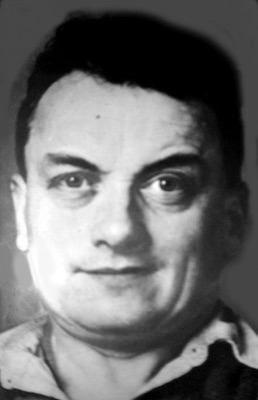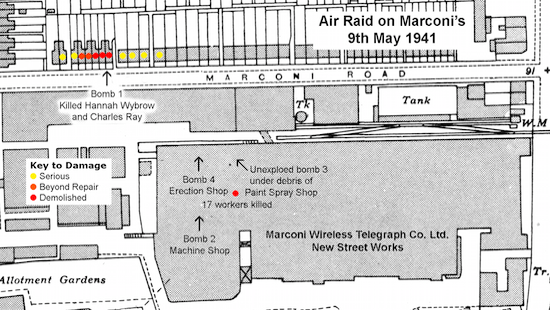Charles Thomas 'Tom' Franklin was born into an agricultural family. He married in 1921 and went on to have two children. By 1941 he was working at Marconi's factory in New Street, Chelmsford and living in Kelvedon. He was killed in May of that year when his work placed was bombed by the German air force.
Charles Thomas FRANKLIN, Civilian
Killed in an air raid on Marconi's factory in New Street, Chelmsford. Aged 46
The fourth bomb, a 250 Kg. high explosive, narrowly missed the Marconi works and fell onto houses in Marconi Road, where two people received fatal injuries. A terrace of six houses near the junction with Bishop Road suffered most as a result, with three demolished (nos. 70, 72 & 74) and two others believed damaged beyond repair (nos. 76 & 78). The sixth house, no. 80, was seriously damaged as were five others (nos. 62, 64, 66, 68 & 82). The combined effects of blast from all four bombs affected around 375 other properties within a quarter of a mile radius with damage mainly confined to windows, doors, roofs and ceilings.
Tom was buried at Coggeshall Cemetery on 14th May 1941.
Tom's daughter who also worked at Marconi's. An account of her experiences following the raid was compiled by the Marconi Veterans Association in 2009 when the plaque commemorating the factory workers killed in the incident was moved from the redundant Marconi buildings in New Street to Chelmsford Cathedral:
"On the morning of May 9th 1941, Joan Franklin (now Joan Josin) left her home in Coggeshall Hamlet at 6 am, starting her journey to Chelmsford where she worked at the Marconi factory. She cycled to Kelvedon and then got on the bus, which meandered its way through the villages to Chelmsford. At Boreham, new passengers alighted, and one announced that a bomb had hit the Marconi factory during the night.
This news filled Joan with fear and dread because, not only was her job in jeopardy, but her father was a night shift worker there. Joan recalls that every morning he would have a few words with her before he went home to bed, as he was anxious about her journey to work as she did not travel well and would arrive at work looking very pale.
Sadly, when Joan arrived at the Marconi factory that morning her worst fears were confirmed. The bomb has crushed large machines into fragments of metal and it was obvious there were casualties.
Just after she arrived, the emergency services started to carry out bodies covered in blankets, but Joan remembers trying to catch sight of feet sticking out. Her father was a metal sprayer and often came home with silver paint on his shoes. Sadly she did not see him and was told to go home.
A telephone call later in the day confirmed he had died. Next morning Joan had to go to GSalleywood Race Course to identify his body. Among a pile of personal items retrieved from the damaged factory, and taken to the Race Course, she found her father's wallet (complete with a photograph of her mother), his ID card and the bowl, but not the stem, of his pipe. She still has these items.
Charles Thomas Franklin, (known as Tom) is buried in the Churchyard of St. Peter's, but his funeral service took place at St. Nicholas Chapel because St. Peter's Church had been bombed eight months earlier. Joan believes her father was the only civilian Coggeshall resident to have died as a result of enemy action."
A Chelmsford newspaper reported:
"COGGESHALL FORESTER DEATH. The funeral took place on Wednesday of Mr. Charies Thomas Franklin, of 9 New Road. Little Coggeshall who died as the result of enemy action. Mr. Franklin was 46. and leaves a widow, one son. and one daughter. The Rev. F. N. Brown, vicar, officiated. The principal mourners were: The widow; son and daughter; Mr. Bernard Franklin, brother: Miss Winifred Franklin, Mr. and Mrs. Sage. Mr. and Mrs. Locke, sisters and brothers-in-law; Mr. and Mrs. Clarke. Mrs Pewk. brother and sisters-in-law; Mrs. H. I. Lucas. Mr. H Joslin, Mr. Maurice Hatt. and fellow workers. Among the beautiful floral tributes were those from the deceased's employers and fellow workers. The Foresters' funeral oration was read at the graveside Bro. H. L. Rulton."
Charles left an estate valued at £162 4s. 9d. His widow died in 1989.
Victor Arthur Joslin, whose brother was to marry Charles' daughter in 1942, was also killed in the incident.
150418
Tom was born in Takeley on 5th June 1894, one of six children of Charles Albert Franklin and Annie Franklin.
His siblings included: Daisy Mary Franklin (born in 1896), Kathleen Ruby Franklin (born in Chigwell in 1898), Douglas Franklin (born in Kelvedon in 1902, died in 1940), Arthur Bernard Franklin (born in Kelvedon in 1902), and Winifred Franklin (born in Kelvedon about 1905).
The 1901 census found Tom, aged six, living with his parents and two younger sisters at Woodhouse Farm in Kelvedon, where his father was a horseman. A decade later the 1911 census recorded 16 year-old Tom living with his parents and four siblings still at the farm, and Tom's father remained a horseman, an occupation Tom had taken up.
In 1921 Tom married Jessie Florence Sage. The couple had a son, Douglas Charles Thomas Franklin (1928-1981) and daughter.
By 1941 Tom was working for the Marconi Wireless Telegraph Co. Ltd. as a sprayer at their premises in New Street, Chelmsford. His home was at 9 New Road, The Hamlet, Coggeshall.
Tom died on 9th May 1941, one of 17 workers killed when his workplace was bombed in a skilled raid by the Luftwaffe. He was aged 46. A further 20 people

were seriously injured and 18 others slightly hurt in the factory.
A red air raid warning had sounded the previous evening at 11.24 p.m. but all was quiet until 2.22 a.m. when an enemy Junkers Ju 88 approached the town. Eyewitnesses saw the raider clearly in the almost full moonlight, as it dived to within a few hundred feet of roof tops, released two bombs, circled and dropped two more, before rising rapidly and escaping towards the coast. The aircraft had in fact come so low that those who had seen it thought it likely to hit Chelmsford Cathedral's spire.
Three of the bombs which were dropped scored direct hits on Marconi’s, whilst another went astray and struck residential properties in Marconi Road which ran along the northern side of the factory. Marconi’s was an obvious target for the Luftwaffe. The New Street factory carried out vital work for several Government departments - designing, testing, developing and producing wireless instruments for the Admiralty, Air Ministry, Ministry of Supply and the Crown Agents.
Of the factory’s 3221 workers, some 390 were engaged on the night shift at the time of the raid. They had been on duty since 8.15 p.m. the previous evening and were due to finish at 7.30 a.m., with the day shift taking over fifteen minutes later. The air raid warning had interrupted work of the two hundred or so employees in the machine shop The men there had taken shelter behind an internal blast wall, whilst the women had gone to the strong rooms below the main office building.
The bombs that hit Marconi’s fell at the western end of the main factory building. One, thought to have been a 250 kg. DH high explosive, exploded in the centre of machine shop which occupied the southern half of the building. Another, a 500 kg. DH high explosive, fell on its northern half, through the first floor carpenters’ shop and detonated on the floor of the SWB8 transmitter erection shop beneath it. This bomb ignited a drum of cellulose in the carpenters’ shop and the fire rapidly spread across debris into the neighbouring paint spray shop. There, dope was ignited and several men, who had survived the initial explosions, were trapped behind a blast wall and killed by the fire before rescuers could reach them. The fire was eventually brought under control by 5 a.m., though not before flames had spread to Ridley’s flour mill in neighbouring Townfield Street. Damage there was extensive with a very large number of roof slates lost, timbers charred and internal linings destroyed.
During the day, whilst clearing up operations continued at the factory, a worker reported hearing tapping sounds from beneath the debris of the wrecked paint spray and transmitter erection shops. Immediately, workmen with crowbars and shovels began frantic attempts to locate the source of the sounds but despite their efforts no one could be found and it was decided to terminate any further rescue work as it was concluded that anyone still buried would be dead by then.
On the following day, Saturday 10th May, the large pile of debris was cleared and somewhat alarmingly the source of the tapping sounds was clear to be seen by all - a third 500 Kg delayed action high explosive bomb, lay there unexploded but still ticking. Its serial number Ex 536 could be clearly seen. The Bomb Disposal Squad was immediately called in and the factory and surrounding streets were evacuated. Such was the nature and position of the device that the B.D.S. were forced to detonate the bomb where it lay. A warning was put out to this effect, and at 10.30 a.m. on Monday 12th May the bomb was exploded in situ. Further damage was inflicted to the factory, but fortunately there were no further casualties.
